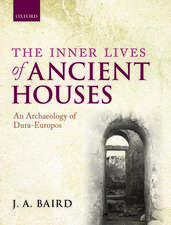The End of the Roman Republic, 146 to 44 BC: Conquest and Crisis
Autor Catherine Steelen Limba Engleză Paperback – 28 feb 2013 – vârsta de la 22 ani
Preț: 219.45 lei
Preț vechi: 241.32 lei
-9% Nou
Puncte Express: 329
Preț estimativ în valută:
41.99€ • 44.90$ • 35.01£
41.99€ • 44.90$ • 35.01£
Carte disponibilă
Livrare economică 28 martie-11 aprilie
Livrare express 13-19 martie pentru 56.04 lei
Preluare comenzi: 021 569.72.76
Specificații
ISBN-13: 9780748619450
ISBN-10: 0748619453
Pagini: 284
Dimensiuni: 156 x 236 x 19 mm
Greutate: 0.43 kg
Editura: EDINBURGH UNIVERSITY PRESS
ISBN-10: 0748619453
Pagini: 284
Dimensiuni: 156 x 236 x 19 mm
Greutate: 0.43 kg
Editura: EDINBURGH UNIVERSITY PRESS
Notă biografică
Cuprins
Section I:146-91 BC; 1. The crises of the later second century BC; 1.1 The Wars in Spain; 1.2 The tribunate of Tiberius Gracchus; 1.3 Rome and the Eastern Mediterranean, 146-122; 1.4 The tribunates of Gaius Gracchus; 1.5 Foreign and domestic politics at the end of the second century BC; 1.6 The outbreak of the Social War; 2. Domestic politics: violence and its accommodation; 2.1 Elite competition; 2.2 Issues and ideology; 3. Imperial power: failure and control; 3.1 The parameters of Roman foreign policy; 3.2 War and imperial expansion; 3.3 The administration of peace; 3.4 Rome and the rest of Italy; Section II: 91-70 BC; 4. Social War, Civil War and the imposition of a new order; 4.1 The Social War; 4.2 Losing the peace: the transition to civil war; 4.3 Domestic politics and foreign affairs in the 80s BC; 4.4 The Sullan res publica; 4.5 The consulship of Pompeius and Crassus: a fresh start?; 5. The limits of autocracy; 5.1 Power and armed force; 5.2 Experiments in autocracy; 5.3 The Sullan res publica; 5.4 Rome, Italy and the Mediterranean; 5.5 Causes of change; Section III: 70-44 BC; 6. The end of the Republic, 70-44 BC; 6.1 The continuing problem of Mithridates; 6.2 Pompeius' campaigns 67-62 BC; 6.3 Italian crises; 6.4 Factionalism, the people, and the collapse of order; 6.5 Foreign Policy in the 50s; 6.6 The last years of the Republic; 6.7 The Civil War; 7. Imperial expansion: novelty and success; 7.1 Patterns of expansion; 7.2 Structures and methods of imperial conquest and government; 8. Elite competition, popular discontent and the failure of collective government; 8.1 Political culture at the end of the Republic; 8.2 The career of Pompeius; 8.3 Popular arbitration; 8.4 The implications of Caesar's dictatorship.



















